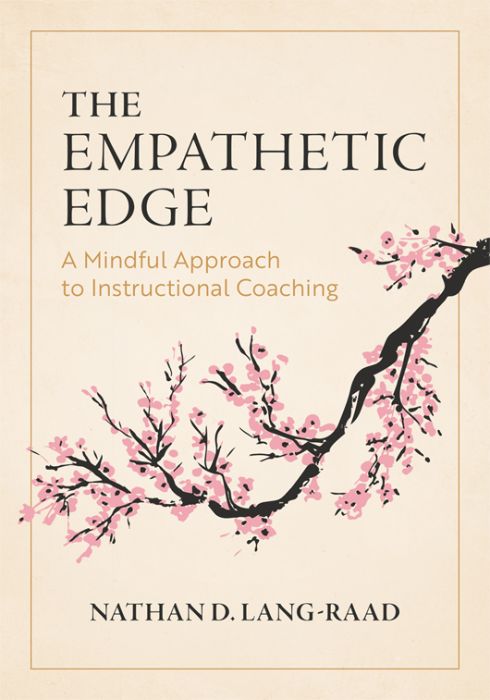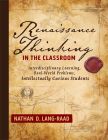
The Empathetic Edge
A Mindful Approach to Instructional Coaching
Using templates and tools to improve their self-awareness, communication, and connections, coaches who read The Empathetic Edge will learn to face adversity with inner peace and to help their colleagues grow in mindfulness of their circumstances, their concerns, and their goals.
Strategies for empathy, awareness, and connection in instructional coaching
Even the best instructional coach can find presence, empathy, and connection challenging to uphold under constant pressure. In this book, Nathan D. Lang-Raad shares coaching approaches to build stronger partnerships through active mindfulness and empathetic understanding stemming from genuine human connection. Learn tangible ways to handle challenges and reshape resistance, leading to productive outcomes and professional growth.
K–12 instructional coaches can use this book to:
- Adopt coaching practices that foster engaged presence and mindful awareness
- Maintain balance, peace, and self-control amid conflict, stress, and change
- Promote open, respectful communication to build trust and compassion with colleagues
- Exercise patience, loosen expectations, and set realistic goals when adapting to change
- Practice daily gratitude and celebrate all measures of progress in transformational growth
Related Topics
InstructionLeadershipTeacher Efficacy
Additional Information
“This book showcases what instructional coaching is all about: building trust, listening, and supporting educators. Nathan Lang-Raad shares strategies backed by research, with real examples that reflect the work we do in schools on a daily basis. The Empathetic Edge reminds us why instructional coaching matters and the impact we can have when we lead with empathy.”
“I LOVE IT! As a coach and educator, it fills in some of that space and nails a truth a lot of coaching books miss. I say all the time: Strategy and curriculum expertise aren’t enough. What matters is presence. This book supports my people-centered leadership approach and gives me practical protocols I can actually use tomorrow, while also affirming to me that coaching isn’t just about doing, it’s about being.
“I would use the frameworks (PAUSE, BLOOM, and ECHO) to provide quick resets, structured ways to engage, and tools for deeper empathy. The resistance strategies are spot on.”
“The Empathetic Edge fills a crucial gap in the coaching field. Empathy is often talked about but rarely operationalized. This book changes that. Nathan Lang-Raad gives coaches and leaders a clear, actionable path to cultivate mindfulness and empathy in daily practice. His frameworks and tools help coaches slow down, notice what really matters, and respond with clarity instead of unconscious habits.
“Every chapter helps you connect the most important dots about the complexities of coaching and the emotional work of change. The tools and reflection prompts make empathy teachable, repeatable, and sustainable for any leader.
“This is a book for coaches and leaders who want to move beyond compliance conversation toward meaningful growth. It helps you see the person, not just the problem, and equips you to lead with presence and purpose.”
“I highly recommend reading The Empathetic Edge by Dr. Lang-Raad. Dr. Lang Raad has gone beyond simply offering new coaching techniques by providing a powerful framework for cultivating mindfulness, connecting deeply with teachers, empathy, and presence in instructional coaching. Through research, this book is paired with real-world narratives by showing how human capital and authentic understanding can enhance and transform professional cultures. Ultimately, The Empathetic Edge goes beyond traditional strategy-focused models and supports teacher growth through trust and interdependence.”
“In The Empathetic Edge: A Mindful Approach to Instructional Coaching, Dr. Lang-Raad provides the field of instructional coaching with what it has been craving: an authentic, human-centered approach and theme that places empathy and mindfulness at the core of practice. In a time when coaching is needed more than ever before, coaches must not only know how to coach but also do so in a way that uplifts, empowers, and builds relational trust rather than diminishes.
“Dr. Lang-Raad skillfully highlights the importance of cultivating emotional intelligence to navigate the complexity of the relationships that instructional coaching inevitably brings. By integrating strategies such as gratefulness and mindfulness, he provides frameworks and follow-up activities that allow coaches to sustain themselves while simultaneously cultivating teachers for long-term professional sustainability. This blending of emotional awareness with practical strategy offers both immediate impact and enduring value.
“By the end of the book, the synthesis of this message becomes clear: The future of instructional coaching lies not only in accumulating more techniques and improving your ability to coach but also in developing deeper wisdom about how to support genuine professional growth. When we combine acquired and developed coaching skills with authentic human understanding, we create conditions in which lasting transformation is not just possible but inevitable. As empathetic coaches, we commit ourselves to evolving alongside those we serve, helping to create schools where both teachers and students thrive through genuine understanding, sustainable practices, and growth-oriented support.”
“This book beautifully bridges the art and science of coaching. Through powerful stories and practical tools, it invites us to lead with empathy, listen with intention, and coach with presence. The Empathetic Edge will renew your heart for this work.
“The Empathetic Edge redefines what it means to lead and coach in today’s schools. It offers a masterclass in mindful leadership—grounded, human centered, and deeply actionable. A must-read for anyone committed to meaningful, lasting change in education.”
“Nathan Lang-Raad understands that to lead to real and lasting change, professional growth through coaching must include deeper transformative interactions and address the system as well as the individual. In this book, he does an excellent job of making complex topics (such as how to lead complex change, how to navigate technology, how to support teachers who struggle with perfectionism, and building connections across diverse communities) very concrete as he provides narrative examples of what these look like in real life and then provides strategies to navigate them.”



